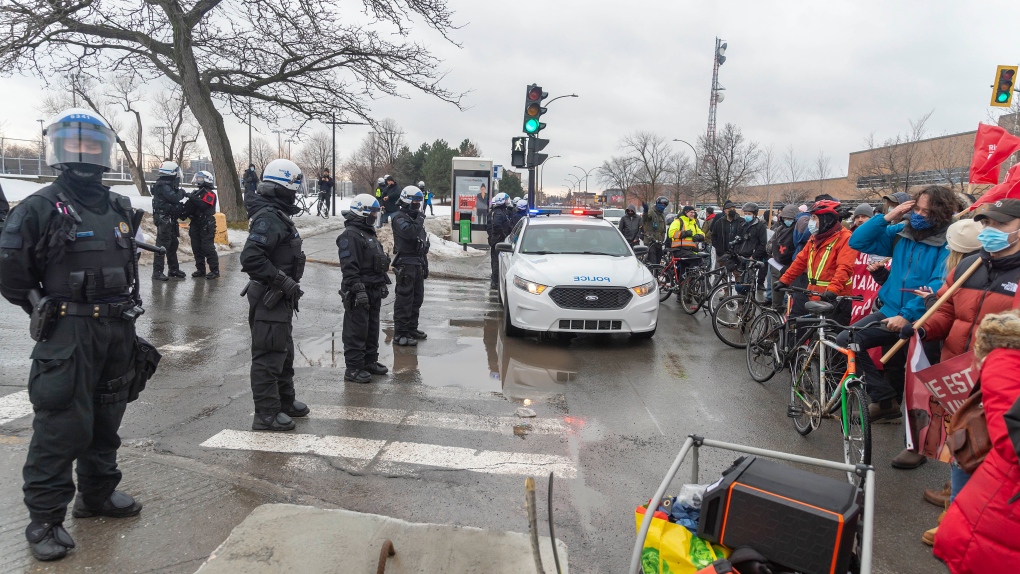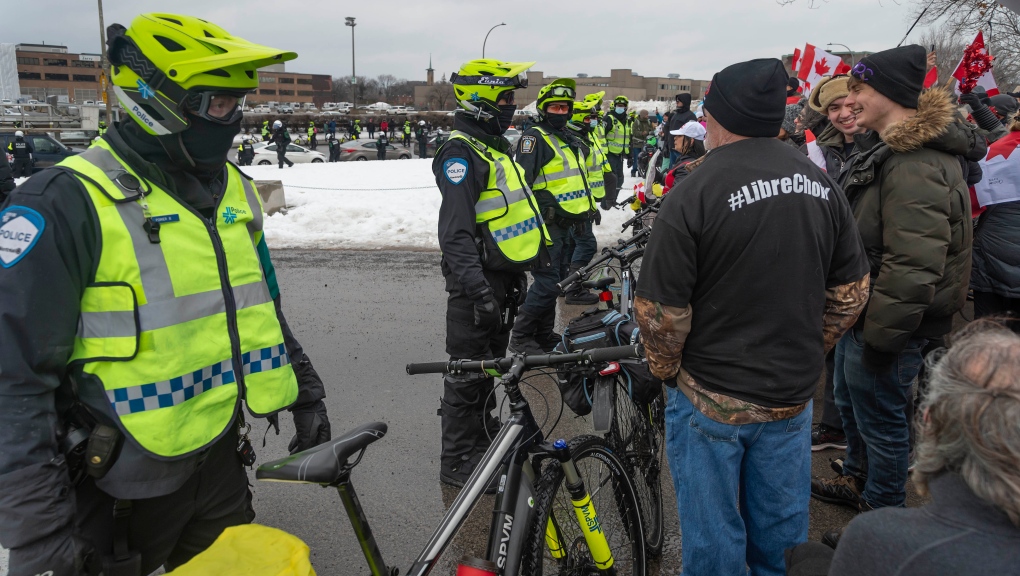Montreal police spotted with 'Thin Blue Line' patches at convoy demonstration
On Saturday, as protesters and counter-protesters descended on Jarry Park in Montreal's Villeray-Parc-Extension neighbourhood either in favour of the Ottawa trucker convoy or against it, they were met by police.
Some of those in the counter-protest group opposed to the 'freedom convoy' protesters were concerned that their group was boxed in by officers in riot gear, some of whom were wearing the controversial "Thin Blue Line" patch -- a symbol banned by some Canadian police forces.
When asked about the patches, the Montreal police media relations department repeated its message from April on the same topic when CTV inquired.
"A comprehensive review of the Dress and Deportment Procedure, which governs standards for the physical appearance and dress of employees, is currently underway at the Service de police de la Ville de Montréal (SPVM)," police said in an email. "This exercise includes the possible positioning of the Service with respect to the wearing of any insignia, an issue that is being addressed by our ethics committee."
Leila Marshy was among the small group of counter-protesters (she estimated about 75-100) opposed to the supporters of the Ottawa trucker convoy, who numbered in the thousands.
She was distraught that police were wearing patches, and that they seemed more aggressive towards her group.
"They're not allowed, in Quebec, to modify their uniform," said Marshy.
The SPVM said they made no arrests and did not hand out any tickets on Saturday, and the protests were over by the late afternoon.
The patch in question features a black Canadian flag with a blue line striking through it.
According to The Thin Blue Line Canada's website, where various products are sold and a portion of profits donated to assist families of Canadian and American officers killed in the line of duty, the patch is meant to "commemorate fallen law enforcement officers and to show support for law enforcement in general."
Quebec's 2017 law - Bill 133 - prohibits police officers from modifying their uniforms after officers wore camoflauge pants, jeans and other non-authorized items while protesting reforms to their pension plans.
"Every police officer or special constable must, while performing his or her duties, wear the full uniform and wear or carry all the equipment issued by the employer without substituting any other element for them," the Police Act rule reads. "He or she may not alter them, cover them substantially or in a way that hides a significant element or hinder the use for which they are intended."
Other forces such as the RCMP and the Ottawa Police Service have banned officers from wearing the patches.
For Marshy, officers wearing the patches and focusing their attention on her small and relatively quiet group (one protester had a megaphone) was disconcerting.
"Certainly we weren't scary and we weren't being threatening and nobody was charging anybody," said Marshy. "They had rows of riot police maybe one or two deep... We were boxed in tightly and they were standing there in combat stance with their shields and their helmets, visors and batons and some of them had long guns."
 Montreal riot police stand near protesters against COVID-19 restrictions march through the streets of Montreal on Saturday, February 12, 2022. THE CANADIAN PRESS/Peter McCabe
Montreal riot police stand near protesters against COVID-19 restrictions march through the streets of Montreal on Saturday, February 12, 2022. THE CANADIAN PRESS/Peter McCabe
Montreal riot police stand near protesters against COVID-19 restrictions march through the streets of Montreal on Saturday, February 12, 2022. THE CANADIAN PRESS/Peter McCabe
In contrast, those monitoring the anti-mandate convoy gathering and march functioned more as crowd control in yellow vests.
"It was just sort of general parade cop presence," said Marshy. "They were escorts and our cops were, I believe, trying to provoke something and looking for the slightest misstep on our part to move in and be able to say that we were causing violence."
The Montreal police (SPVM) said it does not comment on intervention strategies "for security reasons."
"We adapt our operations to each situation and to the behaviour of the crowd," the force said. "The role of the SPVM during demonstrations is to ensure that they take place in peace, good order and the safety of people and property, and that they respect the laws and regulations in force as well as the Charter of Rights and Freedoms."
 Montreal police stand near protesters against COVID-19 restrictions march through the streets of Montreal on Saturday, February 12, 2022. THE CANADIAN PRESS/Peter McCabe
Montreal police stand near protesters against COVID-19 restrictions march through the streets of Montreal on Saturday, February 12, 2022. THE CANADIAN PRESS/Peter McCabe
Montreal police stand near protesters against COVID-19 restrictions march through the streets of Montreal on Saturday, February 12, 2022. THE CANADIAN PRESS/Peter McCabe
Marshy left the protest feeling that Montreal's police officers weren't concerned with her or her fellow protesters' safety.
"This is what it has come down to, we're not able to enforce the police," she said. "An extreme example of that is in Ottawa, so nobody dares make the police do their job, and the police don't want to do their job and police want to do a different job."
CTVNews.ca Top Stories

LIVE AT 11 EST Trudeau to announce temporary GST relief on select items heading into holidays
Prime Minister Justin Trudeau will announce a two-month GST relief on select items heading into holidays to address affordability issues, sources confirm to CTV News.
'Ding-dong-ditch' prank leads to kidnapping, assault charges for Que. couple
A Saint-Sauveur couple was back in court on Wednesday, accused of attacking a teenager over a prank.
Joly says next U.S. ambassador Hoekstra will help advance 'shared priorities'
Foreign Affairs Minister Melanie Joly is welcoming president-elect Donald Trump's pick for the next U.S. ambassador in Ottawa.
Estate sale Emily Carr painting bought for US$50 nets C$290,000 at Toronto auction
An Emily Carr painting that sold for US$50 at an estate sale has fetched C$290,000 at a Toronto auction.
Parole board 'working' to have Bernardo victims' families attend hearing in-person
The Parole Board of Canada says it is now working to allow victims' families to attend Paul Bernardo's parole hearing and deliver their victim impact statements in person.
Border agency detained dozens of 'forced labour' cargo shipments. Now it's being sued
Canada's border agency says it has detained about 50 shipments of cargo over suspicions they were products of forced labour under rules introduced in 2020 — but only one was eventually determined to be in breach of the ban.
Ontario man agrees to remove backyard hockey rink
A Markham hockey buff who built a massive backyard ice rink without permissions or permits has reluctantly agreed to remove the sprawling surface, following a years-long dispute with the city and his neighbours.
2 boys drowned and a deception that gripped the U.S.: Why the Susan Smith case is still intensely felt 30 years later
Inside Susan Smith’s car pulled from the bottom of a South Carolina lake in 1994 were the bodies of her two young boys, still strapped in their car seats, along with her wedding dress and photo album. Here's how the case unfolded.
This is how much money you need to make to buy a house in Canada's largest cities
The average salary needed to buy a home keeps inching down in cities across Canada, according to the latest data.

































